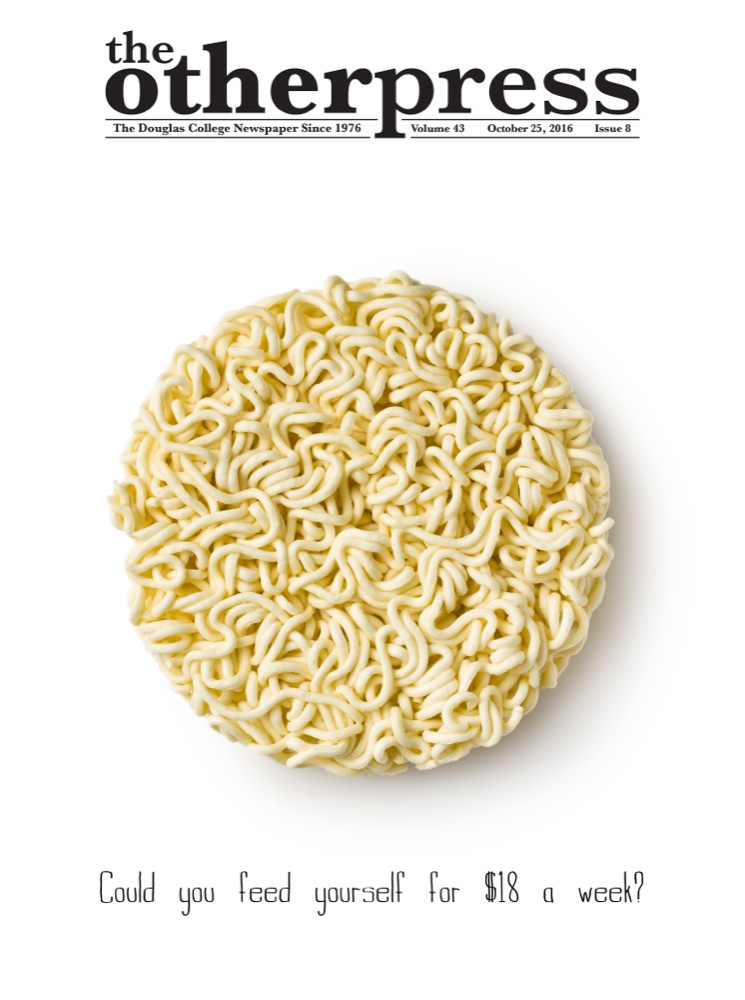
A thought-provoking challenge casts a new light on welfare rates
By Aaron Guillen, Staff Reporter
Recently, I participated in the Welfare Food Challenge, which took place from Sunday, October 16 to Saturday, October 22. The challenge took place for the fifth time thanks to the support of Raise the Rates, an alliance of organizations hoping to improve the current state of homelessness and extreme poverty in BC, specifically for people on welfare. Over the week, individuals were only able to eat the food they could buy with $18. The challenge restricted participants from using any food banks, charities, pre-brought food, home-grown food, or free food from friends and family.
In an effort to buy food with the biggest ‘bang for my buck,’ I headed to Buy-Low Foods, a grocery store I had assumed would offer low prices. Unfortunately, I had underestimated the time it took to pre-plan an entire week’s worth of food in a single shopping trip. After comparing prices up and down the aisles for at least 45 minutes, I made my way to the cashier with two corn on the cobs, two cans of pasta sauce, two packages of linguine, one box of all-bran flake cereal, and a four litre jug of chocolate milk (50 per cent off due to upcoming expiry). The total came to $16.89. The experience of shopping for items on a budget, in itself, was an aspect of the challenge I hadn’t prepared for. Nevertheless, with a rather unbalanced diet, I figured myself ready to face the week ahead.
Day One
I began with breakfast (a bowl of cereal and chocolate milk) before I dashed off to class. Throughout the day, I was able to sustain myself on water without feeling hungry. In retrospect, I had stuffed myself the night before to prepare for the daunting week that lay ahead. I noticed that I was easily annoyed at the slightest things, such as students taking too long explaining their points in class. Dinner consisted of spaghetti and pasta sauce, and I went to sleep wishing that I could have bought coffee or an Iced Capp at Tim Hortons.
Day Two
I began with the regular breakfast, but for lunch I enjoyed two corn on the cobs. Halfway through my day, I struggled with the idea of ordering a pizza. I would pick up and dial the phone, but when the employee answered, I immediately hung up. In the evening, I found myself at Bible Study, and I convinced myself that I could eat the food there because it didn’t cost me a cent. I was in such a state of denial that I didn’t feel any remorse.
Day Three
I started off with the same old breakfast I had eaten the day before, but lunch brought a new flavour. At church, still riding the wave of denial, I gladly joined in on the potluck. After the lunch, my friends and I packaged hygiene kits for the homeless, fueling my denial by convincing myself I had done a fair share of goodwill, resulting in two slices of pizza at a party that evening. At this point, I questioned how hard it was to truly be on welfare, and I concluded midway that it was easy enough—after all, I had been not spending any extra money.
Day Four
I woke up at 10 a.m. and rushed to my grandparents’ house for a family dinner, with only a glass of water in my stomach. At their house, I took part in the delicious meal prepared. I savoured every single bite, and ended the day by drinking only water for dinner. Guilt overcame me, and I pledged to myself that I wouldn’t crack again.
Day Five
I was determined to complete the challenge without caving… anymore. Breakfast and lunch went by smoothly, but on my way home from class, I spotted a pizza place out of the corner of my eye. The sheer fact that I was restricted to go without spending for the week pushed me over the edge, and for the first time, I spent money and bought two slices of pizza. I had lost all self-control; the power I lost was regained and an immediate wave of remorse flooded over me.
Day Six
I introduced stricter guidelines, but due to the food I consumed outside of my $18, I had excess and didn’t have to worry about rationing. The usual breakfast accompanied the spaghetti dinner. On this day, I had a midterm, and I remember not being able to focus. Whether that was effected by my hunger, or my lack of an attention span, I tried to pull all the facts I had learned from the class and place them onto the paper. It proved a challenge, but I managed.
Day Seven
Far gone by now, the only means of redemption for me was to stay true to the promise I had once held strong six days ago. I started off the morning with one final pour of chocolate milk into a bowl of bran cereal and made my way to class. For the first time that week, my stomach growled. The growls reached an unbearable limit while studying in the library. My day ended with a spaghetti dinner and the undying excitement that the moment I woke up the next day, I would finally be free from the restrictions of the challenge.
So why $18?
“[To calculate the cost for the challenge], we use the cheapest rent (currently $479) in the province as the benchmark,” explained Bill Hopwood, Raise the Rates organizer.
“Most people spend more on their rent, but that is the average amount for a Single Room Occupancy (SRO). The city of Vancouver only provides $375 a month for shelter, so other expenditures have to be reduced or cut.”
For the first time in five years, the price of the challenge has dropped to an all-time low of $18 due to an aggressive housing market. The first two years (2012 & 2013) were at $26 and the following two (2014 & 2015) were at $21. In addition to the cost of shelter in the challenge calculations is the price of a bus pass; Hopwood noted that if they included that additional fare, the challenge would’ve had to be completed with a measly $13.
“[The realization hit] that no one was going to do it, but in the same context, this is a reality for many,” he pointed out.
“When it costs $2.75 for one-zone bus fare, most of your money for a day’s food is spent. That’s why they ride and don’t pay. So we took out the bus travel expense, which I think is more realistic on how people on welfare survive—they ride or they walk. Generally, most bus drivers are fine [with giving an individual a free ride], but if you get caught by an inspector, you get a $173 fine. Most people on welfare have several tickets unpaid. Eventually, they become criminalized. In that sense, that’s what poverty does to people—it turns them into criminals when the only crime they’ve actually committed (and it isn’t even a crime) is by being poor.”
Most people can easily spend $18 in a single day, perhaps even on a single meal, but simply by drinking water instead of coffee, there’s a small yet significant difference. Many people start off their food challenge week convinced that they can be successful, but they soon discover it is physically impossible, especially in the long term.
Six years ago, Raise the Rates organized the MLA Challenge, in which Jagrup Brar, former MLA Surrey-Fleetwood, survived on $610 for an entire month. By the time he was done, he had lost 27 pounds. Hopwood recalled a joke at the time saying that if Brar continued the challenge for the next nine months, he’d disappear. After completion, it was apparent that the likelihood of another politician’s participation was slim to none. That was when they thought of a way to produce the same experience without going to extremes. The Welfare Food Challenge was born.
“Once we put it out there, it took off in a powerful way we had never expected,” Hopwood commented.
“It was [the fact] that an individual’s experience lead to a conversation. It truly brought home the fact just how important food is—not only to our physical, but to our emotional well-being. Thanksgiving wouldn’t be the same with a glass of water and crackers. Within a week, we’ve seen participants become irritable, hot-tempered, and stressed. If this was only one week, what more for six months, nine months, a year?”
Hopwood believes that the provincial government makes excuses to justify extreme poverty by suggesting that if only individuals were wiser and more sensible, they could cope with being poor. In their first year, a dietician and trained chef did the challenge and admitted that there was no way to eat a healthy and balanced diet on $26 for a week. This begs the question: Are those on welfare better off today?
Alas, the welfare rate of $610 hasn’t changed one bit. While the personal disabilities rate has been tinkered with a bit (raised by $77), the BC government took away the free bus pass/transportation service it came included with and began charging $52 for it.
“With the current cost of poverty in BC being between $8-9 billion, and the cost to fix it around $4 billion […] the BC government is being quite frugal with their money, money that has the potential to help thousands of people,” shared Hopwood.
“Certainly, the argument that remains to legitimize poverty is questioning whether these people deserve it or they chose it. Fact is, most people are on welfare because of serious health problems, injury, fleeing domestic violence, leaving broken families, or long-term unemployment,” he said. “In addition to the Welfare Food Challenge, we’ve done this project called We Can’t Afford Poverty, which is based around art that will be rolled out in the next month or so in the Downtown Eastside Heart of the City Festival. Our goal is to use art to tell the emotions of what it is like to be forced into poverty by the government. The project hopes to provide a much more human face, proving that they’re just like you and me—but with too much bad luck, suddenly they’re on welfare.”


